 |
THEIR LAST NIGHTA brief account of a World War II bomber’s
final mission, it’s crew and it’s ultimate fate. |
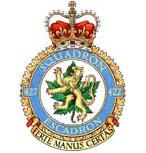 |

THE AIRCREW OF DK 253
Alfred Gaiger David Coe Eric Potts Harold Frost
Kendall Begbie Alexander Chibanoff Frederick Webb
INTRODUCTION
The following is an account of an event that the author witnessed as a child of eight years of age. Some thirty five years later in 1978 a serious attempt was made to investigate and find out more about this aircraft and the men that died in it. In the following year I was fortunate in having access to a meticulously kept diary of the late Mr Wild an A.R.P. warden and a farmer in a neighbouring village of Sipson. This diary documented local war time events from 1939 to 1945 and confirmed the date as that of the 16th Sept 1943. The current rumour at the time was that it was crewed by Canadians, as a member of the Civil Defence Corps being first on the scene identified a Canadian accent from a crew member who tragically died on route to hospital.
In order to further the investigation, a visit to the Canadian section of the Commonwealth War Graves at Brookwood Cemetery helped to locate three grave markers dated the 16th September 1943 and identified the Squadron as No. 427
Located in the National Archives at Kew (formally the public record office) is the Squadron’s Air Record Book, and from this one was able to piece together the full details of the crew, the mission, aircraft type, bomb load and crash details.
In the preparation of this account at the time, I was able to make contact with the U.K. crew’s relatives, and more recently their Canadian counterparts.
My thanks went to Mr Bill Gaiger of Wilmslow in Cheshire, brother of Sgt Alfred Gaiger who supplied the crew photograph. The sisters of Sgt David Coe told me much about his pre-service life where he worked on the Royal Estate at Sandringham, and gave a current photograph of his burial on 21st Sept 1943.
RAF LEEMING is still operational (1978) as a base of the Central Flying School but regretfully no airworthy Halifax bomber exists. In 1973, a partially damaged aircraft was located and raised from the bottom of a Norwegian fjord, after laying there for 31 years following a raid on the German pocket-battleship “Tirpitz” in April 1942. Its condition was such that restoration was not possible, but it is now on display at the RAF Museum at Hendon, North London, alongside another famous WW2 bomber, the Avro Lancaster.
THE EVENT
In the small hours of the morning of the 16th Sept 1943 a Mark 5 Halifax No DK 253 of 427 Royal Canadian Air Force passed over the village of Harmondsworth, formally in the county of Middlesex. (Ordnance Survey Landranger No 176 location TQ 058/777), approximately 13 miles west of London’s Hyde Park Corner. Its altitude was extremely low and in a westerly direction passing over fields where London Airport (Heathrow) is now operating, and jettisoning bombs. It struck the ground adjacent to Cambridge House, the home of the late Mr & Mrs Freebody. The impact was of such intensity that the aircraft bounced some 25 feet high, tearing through the branches of the ash and willow trees lining the river bank of the River Colne, and felling the jib of a dredger parked on the bank side, finally exploding and disintegrating over a wide area of what was then known as Middle Moor. (O/S Landranger No 176 location TQ 052/777). The engines ploughed on ahead, over the river Wyrardisbury and settled in Hawthorn Moor, having travelled a quarter of a mile after initial impact - all indicative of a high speed impact. There was a total loss of life.
[see also an article on this event by Hollie Bridges published in the Canadian Air Force magazine, 11 November 2010]
THE STATE OF WAR
In the autumn of 1943, Europe was still under German occupation. The Normandy landings were still some nine months away and hostilities were to exist for another twenty months. To check the German war machine the air forces of the United Kingdom, the Dominions and the United States embarked on a policy of intense area bombing, the RAF by night and the USAAF by day. In 1943 alone, over 207,600 tons of bombs were dropped by the combined services.
THE AIRCRAFT
To meet this offensive, four-engined bombers were planned and built. They were designed and built for long range operation, affording deep penetration into Germany, carrying what was at that time, unprecedented bomb loads of up to 20,000 lbs. The RAF employed three types of heavy bomber, the Short Stirling being the first to go into service, an aircraft limited as a result of a short wing span. Air Ministry specifications insisted on its necessity to be ‘hangared’ for servicing purposes. The Handley Page Halifax followed in November 1940, to be followed in 1942 by the Avro Lancaster of ‘Dam Buster’ fame.
THE HALIFAX
In 1936, the Air Staff put forward specifications for a twin engined medium bomber. It was designated HP 56, but later specifications called for an aircraft to be powered by four Rolls Royce Merlin engines. This designation was to be HP 57. The designer was George Volkert, the company Handley Page. It was designed to be produced by the split-construction and unit assembly method, enabling rapid construction. Photo lofting techniques were employed where the drawings of the component parts were reproduced photographically on sensitised metal. This enabled accurate machine work to the print-out. These methods were pioneered by Handley Page enabling mass production techniques by shadow factories known as the Halifax Group, comprising English Electric, the Fairy Aviation Company, Rootes Securities (motor manufacturers) and the London Aircraft Production Group formed out of London Transport Organisation at Chiswick and built at Hanworth (West London). The technological spin off from this was employed in the building and construction of the first of the post war London buses - the RT that dominated the streets of the Capital from the end of the war until 1979 when the introduction of the RM bus replaced it.
The first Halifax prototype flew one month after the declaration of war and a total of 6176 were built and saw service throughout the period of the War and remained in squadron service for a further 10 years, in particular the Berlin Airlift, where they were indispensible.
They were not without problems in their earlier life, developing sever instability in flight, but redesigning of the tail plane rudders overcame this, and it became a very reliable aircraft serving a multi role function from meteorological surveys to glider tugs, as well as the role of an efficient bomber. Halifaxes flew 75,000 individual sorties throughout the conflict, the first taking place on the night of March 10/11 1941 on Le Havre. A total of a million tons of bombs fell on enemy territory from Halifax bombers throughout the war.

The aircraft required a crew of seven, namely:- The Pilot, the Navigator, the Flight Engineer, the Wireless Operator, the Bomb Aimer, the Mid Upper Gunner and the Tail Gunner.
Nine Marks of Halifax were built, all at variance with each other by engine type, armament, and only, in the case of the Mark V, the under carriage was by Dowty, and the engines were Rolls Royce Merlin XX, each with a power output of 1,260 Brake Horsepower.
It had an armament consisting of 9 x 0.303 Browning Machine Guns and a maximum bomb load of 13,000 lbs. Its length was 71ft 7ins with a wing span of 104ft 2ins. With a height of 20ft 9ins it weighed 6,000 lbs.
THE SQUADRON ZL
427 RCAF was formed at Croft in County Durham in November 1942 on a nucleus of ten crews from 419 Squadron and eighteen Wellingtons Mark 3, of which sixteen were serviceable. These transferred to RAF Leeming in Yorkshire in May 1943, where the crews underwent the heavy conversion courses on Halifaxes, making their first operational flight on the 28th June 1943. The badge was issued on the authority of King George VI in October 1943 and displayed A Lion Rampant in front of a maple leaf, thereby representing both Britain and Canada. The motto was Ferte manus certas-“Strike Sure”. Its mascot was the Lion and it adopted one of the Prime Minister’s private lions kept at Whipsnade Zoo. The Squadron was in turn adopted by the Metro-Goldwyn-Mayer film company in May 1943 and their first Mark V’s were named after MGM stars.
THE MISSION
On the 15th of September DK253 was assigned its final and fatal operation. The aircraft was a veteran of these operations, having bombed Hamburg, Nuremburg (its longest run), Dusseldorf, Mannheim and the most dangerous run of all –Berlin. It had bombed Leverkusen on the 2nd of August and made back to base with failure of the starboard inner engine. On August 30th it made a bombing run to Munchen Gladbach. Unfavourable weather conditions during the first two weeks of September prevented any further operations, but by the 15th the weather conditions improved over France and at 2035 hours DK253 lifted off the runway at Leeming for the very last time.
The target was the Dunlop rubber factory at Montlucan, an industrial town some 170 miles south of Paris, making it a round trip of approximately 1,200 miles. The aircraft was armed with a bomb load of 5,960 lbs and was one of thirteen aircraft from 427 Squadron. This mission was shared with 20 Halifaxes from 158 Squadron out of Lisset, a station near the coast of South Yorkshire, now Humberside. Of 427 squadron three aircraft returned prematurely with a variety of mechanical problems, the remaining ten proceeded on through the night.
France was considered a nursery run as enemy opposition was considerably less than that encountered over Germany. To quote from a recently arrived crew member of 158 Squadron:
“Being in France was regarded by the rest of the squadron as a ‘sissy one’, but to us of course……today I offer a silent prayer to the Flight Commander who put us on a French target for our first operation. We would not have survived a German raid prancing about as we did at Montlucan. We soon grew up though - our next one was Hanover”.
The weather was good the night of 16th with 6/10 cloud (cloud density is now measured in 8ths) at height of 9,000/10,000 ft over the target area and all debriefing reports confirmed a successful operation, with little enemy opposition. The target was indicated with marker flares previously dropped by Pathfinders and bomber crews debriefing reports confirmed- “Observed T I markers through gap in clouds and bombed through this gap. Observed large and well concentrated fire in the shape of a factory building. Raid appeared to be quite successful.”
(Ext ARB 427 Squadron PRO Kew)
By 0400 hours on the morning of the 16th September nine Halifaxes of 427 Squadron had returned to their base at Leeming without mishap. By 0250 hours that same morning DK 253 lay wrecked in a field at Harmondsworth.
That morning an entry was made in his personal diary by an ARP warden on the site:-
Harmondsworth Moor Incident 16th September 1943
HALIFAX bomber flew in low on a NW and W position (sic) disintegrating
before finally crashing in a field on Harmondsworth Moor, pieces falling in Trustler’s
field and Cedar Farm (*). Bombs jettisoned in Philp’s field (**) behind Eustace
Watkins(***) drawing out all the shop windows along the Bath Road(****) and many
houses near Pinglestone Close, and also shops in Sipson Way also lost windows.
Aircraft exploded on impact killing all crew, petrol tanks exploded, causing huge
sheet of flame. There was no alert at the time.
*Sipson end of Harmondsworth Lane.
**Now inside the airport perimeter (Heathrow L.A.)
***A shadow factory fitting engines into motor torpedo boats. Since demolished.
****A4 London to Bath and adjacent properties.
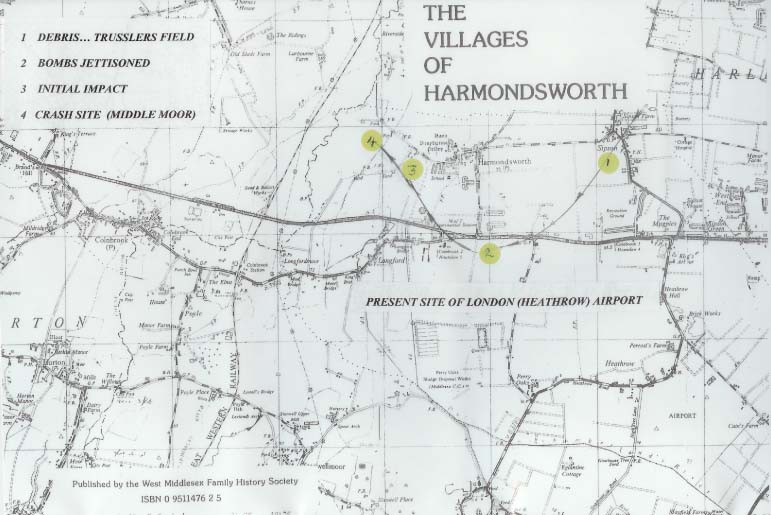
Service held at place of plane crash conducted by Mr Hollis. Scripture by Mr Woolford
Speaker Mr Belch, all members of the local Baptist Chapel. Also in attendance was
the Vicar of the local church of St Mary, the Rev Ross.
He also states that 300 people were in attendance.
-------------------
The following entry was made in the Squadron’s Air Record Book.
Time up Time down
Halifax V Pilot A Chibanoff Flt Sgt R147645 (RCAF) 20.45 -------------
DK2353 R/Air Gunner Sgt HW Frost R188092 (RCAF)
Nav FV Webb F/O J14505 (RCAF)
Bomb Aimer KB Begbie F/O J22698 (RCAF)
W/Op-Air gun A R Gaiger Sgt 137997 RAF (VR)
Mid-Upper Air Gun ET Potts Sgt 1302756 RAF (VR)
F/Eng DR Coe Sgt 1649543 RAF (VR)
Target- MONTLUCAN Bomb load 1 x 2000ib HC Nose INST +
48 x 30lb Inc +600 x 4lb Inc + 30 x 4lb X type Inc
This aircraft failed to return from operation, and is
therefore presumed as missing.
Later information received to the effect that aircraft
crashed at West Drayton* on return to this country with
all occupants killed.
*The site is some 3 - 4 miles south of West Drayton, and it is assumed that this
was used for location purposes as there was an RAF station in the town. ED.
MEMORIALS
In the beautiful surroundings of the Canadian Military Cemetery at Brookwood near Woking in the county of Surrey-maintained by the Commonwealth War Graves Commission-lie the bodies of
Alexander Chibanoff of Glendon,
Alberta, Canada. Aged 22years.
Harold Frost of Toronto, Ontario, Canada. Aged 20 years
Frederick Webb of Vancouver, BC, Canada Aged 27 years
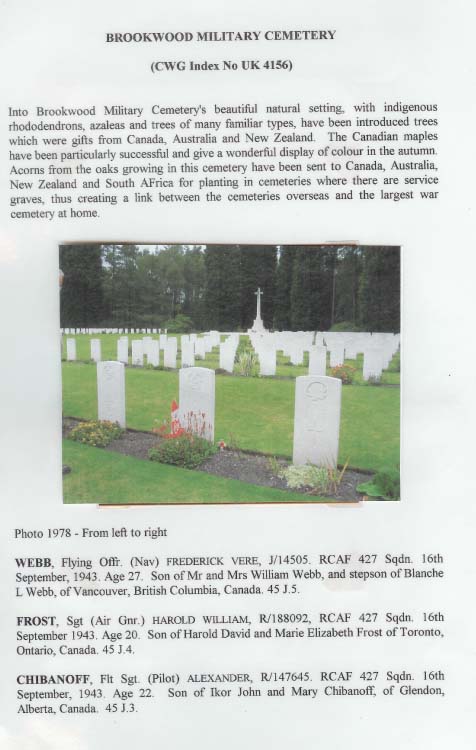
Harold Frost of Toronto, Ontario, Canada. Aged 20 years
Frederick Webb of Vancouver, BC, Canada Aged 27 years

At the Warriston Crematorium, Edinburgh, Scotland, commemorated on a memorial panel, is the name of Kendall Begbie of Riverside, Ontario, Canada.
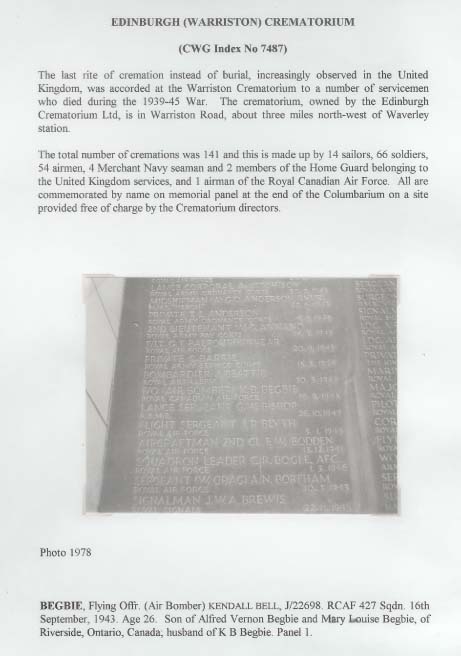
In the quiet churchyard of St Nicholas in the village of Dersingham in Norfolk, England, lies the body of David Coe, aged 19 years
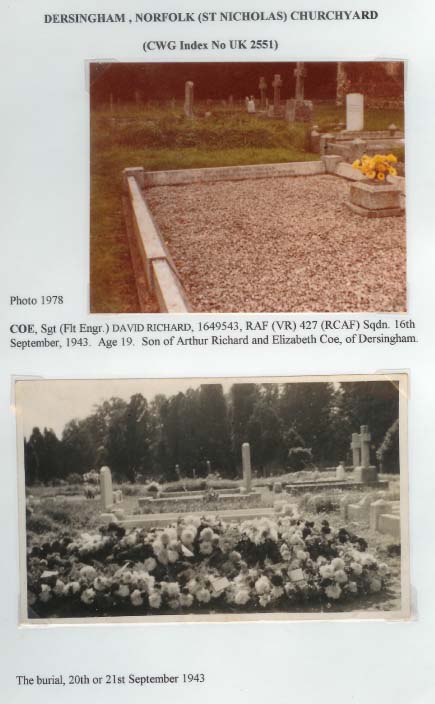
In the town cemetery of the Yorkshire town of Knaresborough, not so distant from Leeming, lies Eric Potts aged 22 years.
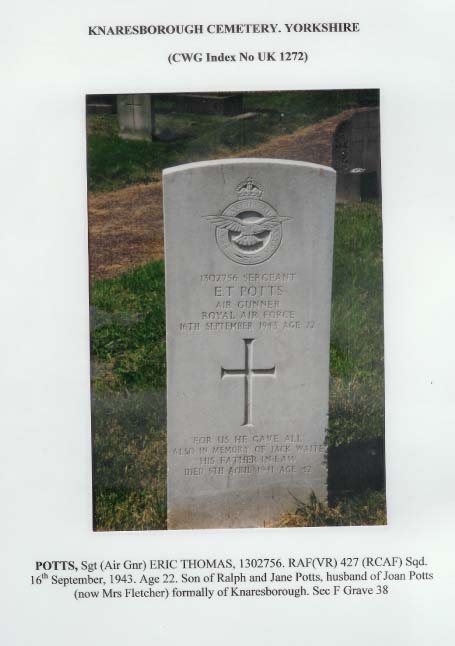
And in the Chorley cemetery near Alderley Edge in Cheshire lies Alfred Gaiger aged 26 years, whose brother died two days later of wounds received at Salerno, and another killed in February of the same year.
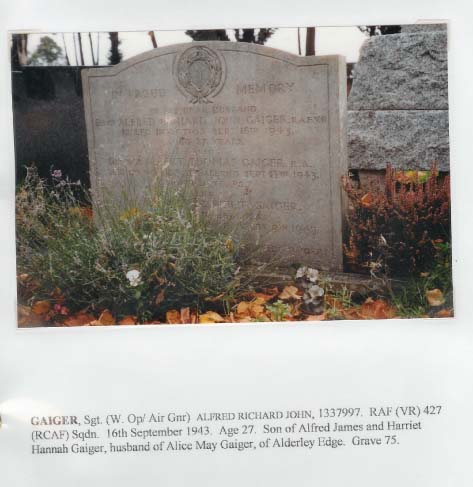
Dedication of The Monument

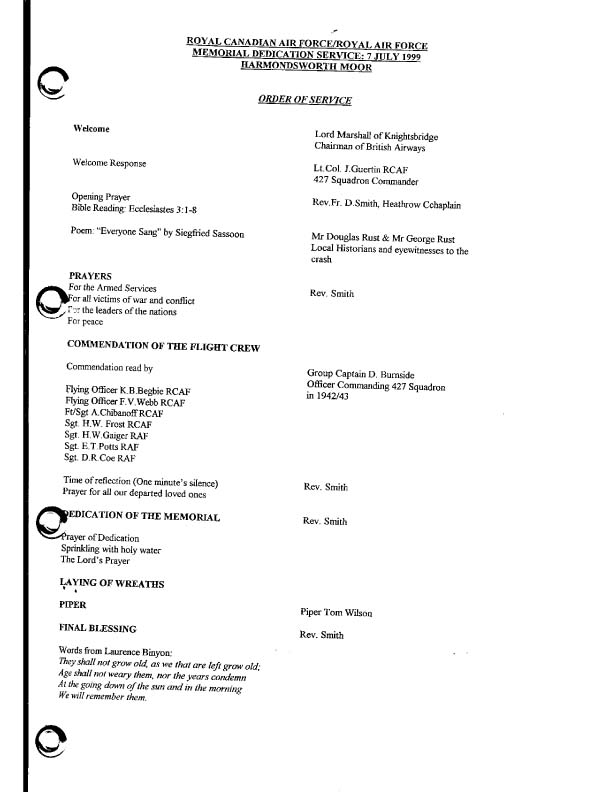
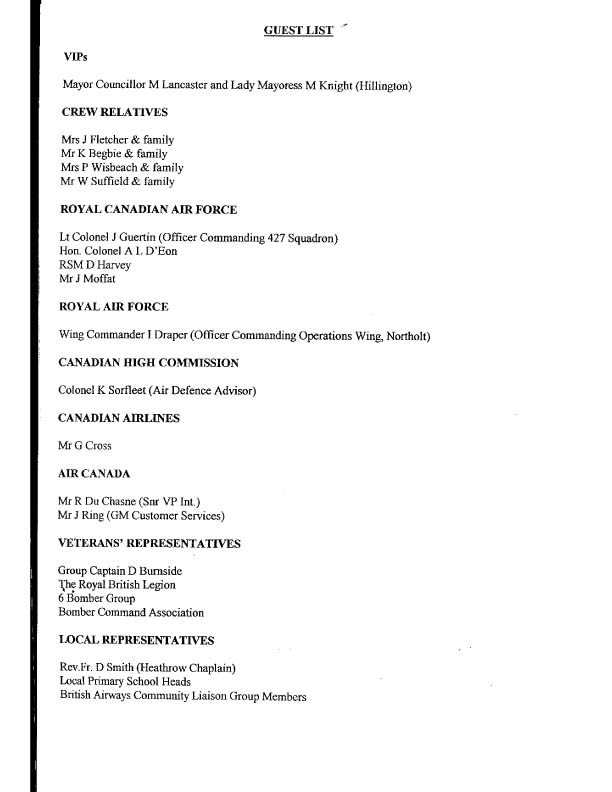

SUMMARY
The purpose of this account was to remove the anonymity of such a tragic event that occurred so long ago, and, by researching, established much that was not known. One thing that was not established at the time of this initial research, was why, after a successful mission, this one aircraft should end its operational life in the fields of Harmondsworth.
1978
In September 1995 documents were received from the family of Frederick Vere Web in Canada, consisting of the Accident Investigation Branch report No W1659 giving a précis account of events just prior to the crash. Whilst this is primary source material, it must be accepted as conjecture.
Acknowledgements
The late Mr & Mrs Freebody for providing the crash guard names, confirming many points and giving their time and patience.
Mrs C Wild - for the opportunity to read and extract the two entries from her father-in-law’s diary.
Captain R N Benwell for his advice on certain points and the use of the crew member’s account after the Montlucan raid – taken from his book ‘In Brave Company’ and co-authored with W R Chorley, and available from the author.
Mr TAE Gibson, Chief Records Officer – Commonwealth War Graves Commission, for the burial records and locations.
Mr W Gaiger for the aircrew photograph.
Mr D. Wheeler - for the photograph of the memorial panel at the Warriston Crematorium.
George Rust
Hampshire, RG 24 9JL
England
1995